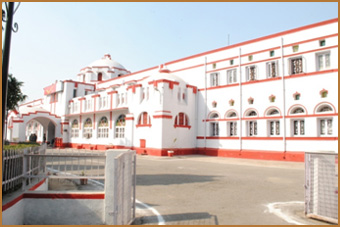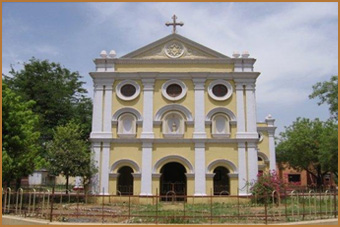| |
 Cantonment Colonial Walk Cantonment Colonial Walk
|
The Cantonment
|
| The cantonments where established in India at the time of British Raj for Army settlements. India currently has 63 cantonments in 17 different states. Majority of Indian cantonments are spread across Northern, Northwestern and Northeastern India. The Cantonment Board Agra was established in the year 1805. It spreads over an area of 1156.474 hectares which includes civil area of 952.55 acres. Agra Cantonment is a wonderful example of the Indo Saracenic Architecture and has one of the exotic collections of Bungalows and other Colonial buildings among the cantonments of India.
|
The Tour
|
After Assembling at Amar Niwas (A Beautiful Colonial Bungalow), where the Guests are been briefed about the British Rule and the Colonial face of Agra with Hi-Tea along with the family of Late Major Amar Singh who served in the Royal British Indian Army.
The tour is been done partly on Tonga’s or Rickshaws (Pedi Cab) and some stretches are done on foot to experience the exotic Colonial buildings within the cantonment of Agra, which is said to be the Colonial paradise of India. The buildings which are been visited in this ride are as under. |
• The Bungalows of Cantonment |
 As you Drive through the Agra cantonment, you’ll see plenty of private bungalows built in the early 19th century, all with the low domes, the large semi-circular arches and the porches common to the era like all other aspects, colonization of Indian also had an impact on architecture style. With colonization, a new chapter in Indian architecture began. The Dutch, Portuguese and the French made their presence felt through their buildings but it was the English who had a lasting impact on architecture. As you Drive through the Agra cantonment, you’ll see plenty of private bungalows built in the early 19th century, all with the low domes, the large semi-circular arches and the porches common to the era like all other aspects, colonization of Indian also had an impact on architecture style. With colonization, a new chapter in Indian architecture began. The Dutch, Portuguese and the French made their presence felt through their buildings but it was the English who had a lasting impact on architecture.
|
• St George's Cathedral
|
 The St George’s Cathedral located in the Cantonment. Designed by Colonel J. T. Boileau, the Garrison Engineer of the cantonment in 1826, it is a beautiful building of yellow ochre stucco with white dressings. The church is conventional and restrained, the entrance being approached through a small vestibule with inches. The interior is divided into a central nave and side aisles by six Ionic columns carrying a slightly vaulted roof. The chancel at the east end has been Gothicized at a later date with a carved white sandstone screen and the altar was enriched with the marble inlay work, for which Agra is famous. |
• Havelock Memorial Church
|
 Havelock Memorial Church, built in honor of one of the British generals of the Indian Mutiny of 1857, is situated in the army cantonment area at Agra,. The Havelock Chapel has been erected by voluntary subscriptions, and bears the name of Sir Henry Havelock, who built the first Baptist chapel in Agra in 1832. This memorial chapel was built in 1873 by the exertions of the Baptist missionary at present stationed in Agra, the Rev. Gelson Gregson. The chapel, including furniture, has cost 12,000 rupees, and is one of the most complete soldiers' chapels in India |
• Post Office
|
 In 1905 the art deco building of the Post Office was constructed in the cantonment. It’s a well-kept structure, painted a crisp white, with a deep red trim that echoes the official colours of India Post. The large arched windows, the shallow dome on top, and the somewhat fussy pillars and niches and narrow windows that punctuate the facade are all quite quaint, and the fact that this is a public building means it’s accessible to all. |
• St. Mary’s Church
|
 Near the Post Office is another building worth a look, if only for the history. This, just behind the Post Office, is St Mary’s Church, a Catholic church commissioned by the John family. The Johns were descended from a Greek diamond merchant named Joanides; the Johns themselves went on to become important industrialists in Agra, owning what came to be known as the John Mills along the bank of the Yamuna. St Mary’s Church isn’t as splendid as the Cathedral of the Immaculate Conception, but with its distinctly Italianate facade (topped by a crucifix and a six-pointed Star of David), in pale yellow and white, is attractive enough. |
• Telegraph Office
|
 The first telegraph line in India was laid from Calcutta to Agra. The work connecting Agra and Calcutta telegraphically was started in Nov 1853 ,and the work was completed in March 1854. The first telegraphic message was exchanged between the capital of India and capital of north west province on March,25 1854.it took One hour and fifty munities for the message to be converted from one end of the wire to another . |
• Queen Empress Mary Library
|
 An Agra telegram, dated 4th instant says: Messrs A John and Co, are presenting Agra with a library, including a valuable house, land, furniture, books, and upkeep, to be called “Queen Empress Mary Public Library,” in commemoration of the first visit to Agra of the Queen-Empress. Now the care taker of this library is a Portuguese lady who spends most of her time in Goa. |
• Sadar Bazar ( local market of Cantonment)
|
 Sadar Bazar was the Market place for the people living in the cantonment areas developed by the British , Sadar Bazaar is one of the most popular shopping destinations for the locals. Sadar Bazaar, is located to the west of Khari Baoli. The market is conveniently located pretty close to the Agra Cantt Railway Station. Sadar Bazaar is highly reputed market in the city of Agra. |
• Mother Teresa orphanage
|
 Mother Teresa founded the Missionaries of Charity in Kolkata (Calcutta), India in 1950. For over forty years she ministered to the poor, sick, orphaned and dying while guiding the Missionaries of Charity’s expansion, first through India and then to other countries. At the time of her death, they were operating 610 missions in 123 countries, including hospices and homes for people with HIV/AIDS, leprosy and tuberculosis, soup kitchen, children and family counseling programs, orphanages and schools. Mother Teresa’s Charity home in Agra has 48 children who are orphaned or come from poor families who can no longer provide for them |
• Company Garden
|
 The Company Garden is established in the heart of the Cantonment along with Adams Tank , where generally the families of the British officers would come out for walks and enjoy the splendors of Nature along with Boating. The Company Garden is established in the heart of the Cantonment along with Adams Tank , where generally the families of the British officers would come out for walks and enjoy the splendors of Nature along with Boating.
|
| |
This tour takes about 2 hours covering Approx 4 km, after completion of the tour the guests are being dropped back to Amar Niwas where the tour ends with refreshments along with the Host family. |
| |
|